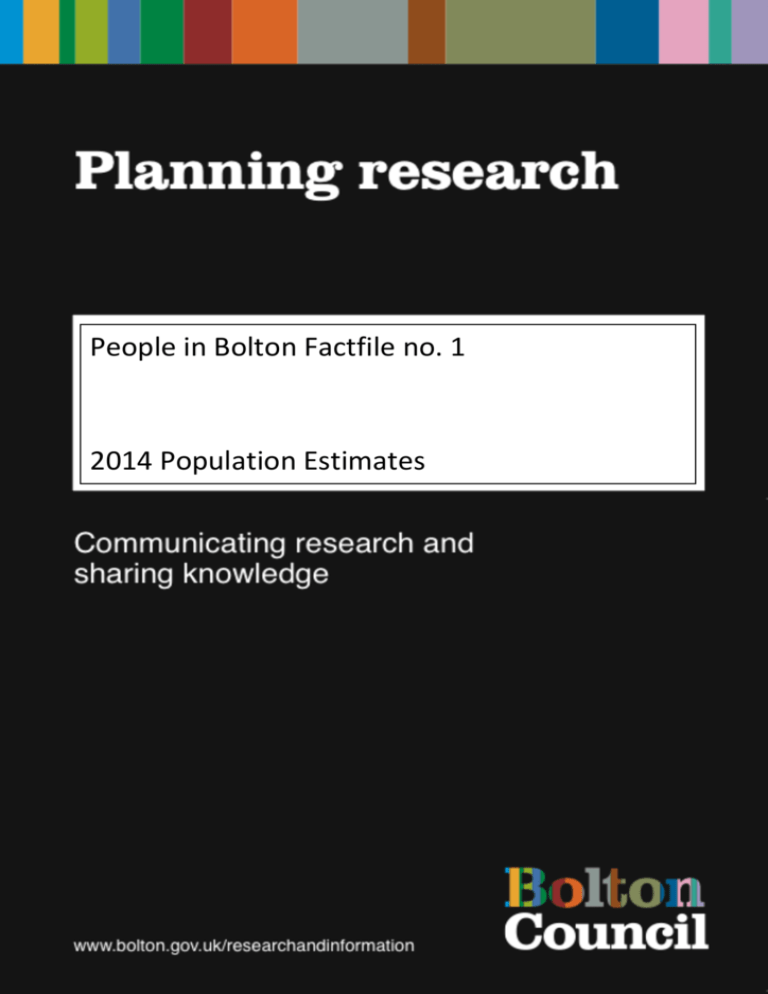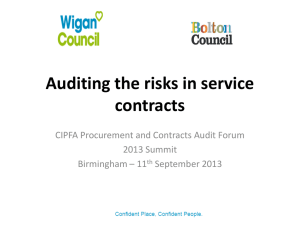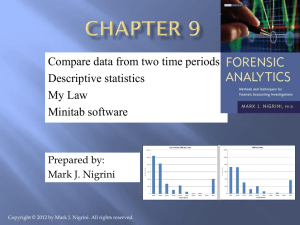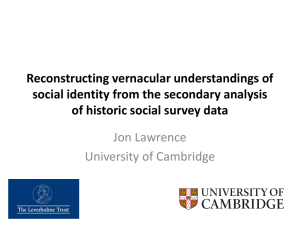People in Bolton Factfile 1 2014 Population Estimates
advertisement

People in Bolton Factfile no. 1 2014 Population Estimates People in Bolton 2014 Population Estimates Factfile - Updated July 2015 People in Bolton factfiles provide key facts and figures about people who live or work in the borough of Bolton, and bring together information from a variety of sources. They are an evolving resource which are regularly updated to include more recent information as it becomes available. Other related publications, including more detailed information on a range of topics can be accessed at: www.bolton.gov.uk/researchandinformation This factfile tells you approximately how many people live in the borough, as well as their age structure. It also explores how Bolton’s population has changed over the past ten years, as well as the reasons for that change. It includes analysis of the Mid-Year Estimates, which are produced by the Office for National Statistics. The factfile is set out in the following sections: 1.1 Population Estimates 2 1.2 Age Structure 4 1.3 Births, Deaths and Migration 6 For more information contact: Planning Strategy Development and Regeneration 2nd Floor Wellsprings tel: 01204 336112 email: censushelp@bolton.gov.uk Population Estimates Factfile 1 1.1 Population Estimates Mid-Year population estimates for 2014 were released in June 2015 and provide an update to the population information previously released by the Office for National Statistics. The estimates tell us how many people live within each local authority and provide information on the structure of the population in these areas by age and sex. The official 2014 mid-year estimates build on the 2011 Census based mid-year estimates, updated to account for population change during the period 2013-14. A combination of registration, survey and administrative data are used to estimate the different components of population change. In mid-2014 Bolton was home to approximately 280,400 people, with 141,500 females and 139,000 males. This is an increase of 300 people, or 0.1% over the previous 2013 estimate of 280,400. Bolton Mid-year estimate (number) 2010 2011 2012 2013 2014 275,200 277,300 279,000 280,100 280,400 Annual Change (%) 0.8% 0.8% 0.6% 0.4% 0.1% Greater Manchester Mid-year Annual estimate Change (number) (%) 2,661,900 2,685,400 2,702,300 2,714,900 2,732,900 0.8% 0.9% 0.6% 0.5% 0.7% England and Wales Mid-year Annual estimate Change (number) (%) 55,692,400 56,170,900 56,567,800 56,948,200 57,408,700 0.8% 0.9% 0.7% 0.7% 0.8% Source: Office for National Statistics, Mid-Year Estimates 2014. Crown Copyright. Data is rounded to the nearest hundred. The population estimates for mid-2002 to mid-2010 have been revised to bring them into line with the official mid-2011 estimates, which are based on 2011 Census estimates. The former mid2002 to mid-2010 estimates were based on population change since mid-2001. The 2011 Census and the resulting mid-2011 estimates, however, provide a new base point at which is likely to be more accurate. Therefore any 2002-2010 figures shown in this report will not necessarily correspond with figures shown in earlier ones, which should be disregarded. Bolton’s population has been increasing steadily over the past decade, with an increase of 15,900 people in the last ten years (6% of the population). In the last few years however growth has slowed to just 0.1% (or 300 people) in 2013-14, compared to growth of 0.8% in 2009-10. Population Estimates Factfile 2 Bolton Mid Year Estimates 2004-2014 Total Population 285,000 280,000 275,000 270,000 265,000 260,000 255,000 2004 2005 2006 2007 2008 2009 2010 2011 2012 2013 2014 Source: Office for National Statistics, Mid-Year Estimates 2004-2014. Crown Copyright Mid Year Estimates 2004-2014 % Population Change 18% % Change Greater Manchester England & Wales 16% 14% 12% 10% 8% 6% 4% 2% 0% Source: Office for National Statistics, Mid-Year Estimates 2004-2014. Crown Copyright Bolton experienced a lower rate of growth than both Greater Manchester (7.2%) and England & Wales as a whole (8%). Manchester district had the largest population increase with around 17% from 2004-14, and only Manchester, Salford and Trafford districts experienced population growth above the national rate. Bolton’s population growth was the fourth largest in Greater Population Estimates Factfile 3 Manchester. Tameside, Rochdale experienced growth at around 3%, whilst Stockport’s population remained relatively unchanged, with growth at just 2%. 1.2 Age Structure The age profile of Bolton’s population is very similar to the national profile, although the borough has a higher proportion of children and a slightly lower proportion of working age than England. Around 1 in 5 of the population in Bolton is a dependent child (aged 0-15), and slightly less than 1 in 5 is of pensionable age (aged 65+). Greater Manchester % % Bolton No. Children (Aged 0-15) Working Age (Aged 16-64) Older People (Aged 65+) England & Wales % 58,400 20.8 20.1 18.9 175,200 62.5 64.3 63.4 46,800 16.7 15.5 17.7 Source: Office for National Statistics, Mid-Year Estimates 2014. Crown Copyright MALES FEMALES 90+ 85-89 80-84 75-79 70-74 65-69 60-64 55-59 50-54 45-49 40-44 35-39 30-34 25-29 20-24 15-19 10-14 5-9 0-4 15,000 10,000 5,000 0 5,000 10,000 15,000 Source: Office for National Statistics, Mid-Year Estimates 2014. Crown Copyright. Over the past ten years in Bolton, the number of children (aged 0-15) has only increased slightly from 56,200 to 58,400, an increase of just 2,200 or 4%. The numbers of working age people have also increased a little more overall, from 169,100 to 175,200, also an increase of around 4% Population Estimates Factfile 4 However the number of older people has increased dramatically, from 39,300 to 46,800, an increase of around one-fifth (19%). This means there is an extra 7,500 older people living in Bolton compared to a decade ago. 2004 No. Children (Aged 0-15) Working Age (Aged 16-64) Older People (Aged 65+) 56,200 169,100 39,300 2014 % No. % 58,400 21 2,200 4 64 175,200 62 6,100 4 15 17 7,500 19 % 21 No. Change 46,800 Source: Office for National Statistics, Mid-Year Estimates 2003-2013. Crown Copyright Population Estimates Factfile 5 1.3 Births, Deaths and Migration Population estimates are produced by estimating the numbers of births and deaths, and estimating the net population change through migration in and out of Bolton. Mid-2013 Population 280,100 Births 3,800 Deaths -2,400 Natural Change 1,400 Internal Migration -1,500 International Migration 400 Net Migration -1,100 Other Changes 0 Total Change 300 Mid-2014 Population 280,400 Source: Office for National Statistics, Mid-Year Estimates 2014. Crown Copyright. Numbers may not sum due to rounding. Between 2013 and 2014 Bolton’s overall population is estimated to have increased by just 300 people. There were an additional 1,400 people as a result of natural change, i.e. there were 1,400 more births than deaths. However, there was also an estimated overall net loss in the population of around -1,100 people due to migration. This was mainly due to the net loss of around 1,500 internal migrants (people moving from or to another part of the country), who offset the net gain of about 400 international migrants (people moving from or to another country) by approximately -1,100 people. ‘Other’ changes include changes in any prison populations or boarding school populations, as well as adjustments to ensure that the local authority population sums to the national figure. In 2013 this did not result in any changes to the overall figure in Bolton. Population Change from 2013 to 2014 Bolton Greater Manchester England 0.6% % population change 0.4% 0.2% 0.0% -0.2% -0.4% -0.6% Natural Change Internal Migration International Migration Source: Office for National Statistics, Mid-Year Estimates 2014. Crown Copyright. Population Estimates Factfile 6 Bolton has a relatively high birth rate, meaning that it has a relatively high rate of natural change compared to England, and a similar rate to Greater Manchester. However in 2013-2014 Bolton suffered a significant loss in population due to internal migration, and had a smaller rate of change in international migration compared to both Greater Manchester and England & Wales. In terms of internal migration the only Greater Manchester authorities who gained in internal migrants were Trafford, Stockport, Salford and to a smaller extent Wigan – all other authorities experienced a loss, with Manchester & Bolton recording the largest decline. As regards international migration Bolton had was the sixth highest gain in international migrants Manchester & Salford had by far the largest gains in GM. Natural Change from 2013 to 2014 Natural Change Greater Manchester England 1.0% % population change 0.8% 0.6% 0.4% 0.2% 0.0% Manchester Salford Oldham Bolton Rochdale Trafford Bury Tameside Stockport Wigan Internal Migration from 2013 to 2014 Internal Migration Greater Manchester 0.6% % population change 0.4% 0.2% 0.0% -0.2% -0.4% -0.6% -0.8% Trafford Stockport Salford Population Estimates Factfile Wigan Bury Oldham Rochdale Tameside Bolton Manchester 7 International Migration from 2013 to 2014 International Migration Greater Manchester England 0.9% 0.8% % population change 0.7% 0.6% 0.5% 0.4% 0.3% 0.2% 0.1% 0.0% Manchester Salford Population Estimates Factfile Oldham Rochdale Bury Bolton Trafford Wigan Tameside Stockport 8





